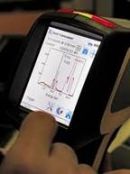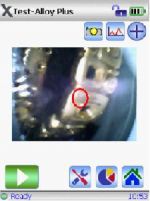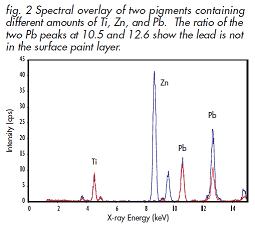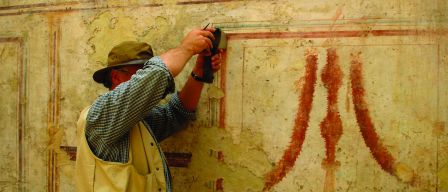Conservation involves the restoration and preservation of museum objects and historical monuments utilizing structural and compositional information obtained from modern analytical techniques. Archaeometry investigates a material's composition, provenance, technology, authenticity and dating using those techniques.
The portable handheld XRF analyzer is the breakthrough system that utilizes an X-ray tube, instead of burdensome radioactive isotopes, for analysis in the field. Its versatile software provides factory calibrations and allows users to generate their own calibration curves.
The DELTA can be configured with an optional camera/collimator to inspect very small areas on valuable objects. | ArchaeometallurgyArchaeometallurgy is concerned with the analysis of metallic objects of cultural value. Investigations are on pieces as small as jewelry or as large as seagoing vessels, such as the H.L. Hunley - the first attack submarine ever constructed. Built in 1863 by the Confederacy, the Hunley attacked and sank the USS Housatonic outside of Charleston Harbor (SC). The sub never returned from her maiden combat voyage, and is sometimes referred to as the "iron tomb." It was located and raised off the coast of Charleston in August of 2000. Hunley preservation and conservation efforts continue today. A critical requirement of this preservation task is to identify accurately the metallurgy of the various components of the sub. The portable XRF analyzer was chosen for this because of its state-of-the-art software, versatile X-ray analysis with multiple filter options - plus the ability to add new elements, new alloy grades and fine-tune calibrations specific to the job. Handheld XRF provides the performance, portability and versatility required for the unique challenges of cultural heritage objects. |
Bronze Age: Copper Based Alloy AnalysisXRF analysis not only offers clues about metals in the relatively late Iron Age, such as for the Hunley, it also answers questions about metals in the Bronze Age - a much earlier time. Some bronze objects are simply two component copper based alloys. More often there are several components. The identity and/or concentration of these help to determine the composition, provenance, technology and authenticity of an object. Commonly produced copper based alloys found from the Bronze Age, including gunmetal and leaded gunmetal, consist of 1-15% Sn/Pb, up to 28% Zn, and Cu making up the balance. Trace levels of other elements, such as Sb, can indicate impurities in the ores and can give information about the object's origin. | 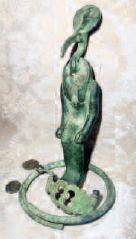 |
The presence of Zn at levels higher than 28% or the absence of other trace elements can indicate that the piece is from a time period after the Bronze Age. Copper based alloys are very simple to analyze with XRF. Detection limits in alloys range from 0.1 to 0.5% depending on the element and the sample matrix. An XRF spectral overlay of two different bronze alloys can be seen in Figure 1. | 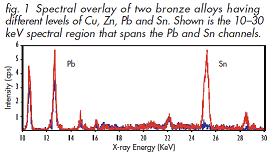 |
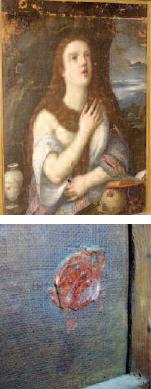 | Paintings and Art Objects: XRF Analysis for Authentication and ConservationAs we all know, everything isn't always what it seems or what someone says it is. When there is any doubt about the authenticity of a painting or other art object, an investigation is required. XRF can give information necessary to determine the authenticity of a painting by analyzing its pigment or, in the case of ceramics and statues, the base materials as well. Essentially, different pigments have been used at different times in history, at different locations and by different artists. In other words, the materials used to make pigments can vary considerably by artist, region and date. XRF analysis of the pigments can answer the questions of when, where and by whom the pigments were made. If this information does not concur with what is known about the attributed artist's pigment materials, then forgeries can be revealed. The same is true about the base materials of ceramics and statues. Information gained from authentication studies is also used to help repair and restore an object by allowing the conservator to produce materials similar to that of the original art object. For example, the painting shown here is believed to be a 16th Century Venetian portrait of Mary Magdalene. XRF analysis of the pigments used can help to determine its authenticity. The content of the red wax seals on the four corners of the back of the painting can also be analyzed by XRF to learn about its provenance, or ownership trail. |
Pigments are very simple to analyze with XRF. Detection limits in pigments range from 0.01 to 0.1 mg/cm2 depending on the element and the sample matrix. An XRF spectral overlay of two different paint pigments can be seen in Figure 2.
Summary
The latest handheld XRF technology offers fast, high-precision measurements of in-situ objects of artistic, archaeological and historical significance. Information gleaned from these studies allows for the restoration and preservation of objects as well as for information on their composition, provenance, technology, authenticity and dating.
Although materials investigated vary considerably - metals, bronze and other alloys, coins, jewelry, weapons, ceramics, glass, statues, religious objects, pigments in paintings and other artifacts - the high accuracy and low detection limits achievable with portable XRF analyzer make it ideal for these unique challenges.
Olympus has developed a handheld, point-and-shoot XRF system that eliminates burdensome radioactive sources and provides on-the-spot quality data of elements significant to art conservation and archaeometry.
The X-ray tube system eliminates NRC regulatory issues, particularly for interstate travel. This handheld XRF system's single "tube" design offers true simultaneous analysis of 20-25 metals, replacing the need for multiple isotopes as used in competing systems.
